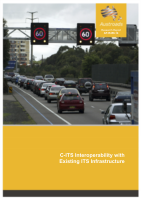Connected and Automated Vehicles

- Publication no: AP-R458-14
- ISBN: 978-1-925037-64-7
- Published: 16 April 2014
- PDF (free) Download
This report defines how emerging C-ITS will integrate with existing ITS currently being operated by Austroads member road agencies. The report is limited to investigating what is required to achieve interoperability between 5.9 ITS (a term used to describe a subset of C-ITS which utilises 5.9 GHz communications) and the selected existing ITS infrastructure of electronic speed limit signs, traveller data collection, traffic signals and traveller information systems.
Interoperability was investigated for the four interoperability levels of technical, syntactical, semantic and organisational. From these investigations it was found that there are changes and elements required to make 5.9 ITS interoperable with the existing ITS infrastructure investigated with many common themes identified. Some of the key common themes include:
- To achieve technical interoperability will require elements such as a 5.9 roadside ITS station and software within the unit to form a 5.9 ITS message
- To achieve syntactical interoperability will require converting the ITS infrastructure content into the syntax required for 5.9 ITS messages
- To achieve semantic interoperability will require forming a 5.9 ITS message that complies with the standardised content and meaning, making allowance for international terminology
- To achieve organisational interoperability requires road agencies to integrate 5.9 ITS with existing ITS infrastructure across all interoperability levels.
While this report discusses the integration between ITS infrastructure and 5.9 ITS, it is acknowledged that some C-ITS functionality could be achieved through integrating C-ITS with existing ITS infrastructure using cellular communications. Additional issues associated with 5.9 ITS integration with ITS infrastructure include privacy, security, certification, liability, management of ‘big data’, private–public partnerships, field operation tests/trials and location and extent of 5.9 roadside ITS station deployment.
- 1. Introduction
- 1.1. Purpose
- 1.2. Report Structure
- 1.3. Context of the Report
- 2. Background
- 2.1. C-ITS Applications
- 2.2. Interoperability
- 2.2.1. The Need for C-ITS to be Interoperable with Existing ITS
- 2.3. Architecture
- 2.3.1. System Architecture
- 2.3.2. Reference Architecture for Australia and New Zealand
- 2.3.3. ITS Station Architecture
- 2.3.4. C-ITS – One Part of a Broader ITS Architecture
- 2.4. Standards
- 2.4.1. General
- 2.4.2. Application
- 2.4.3. Facilities
- 2.4.4. Network and Transport
- 2.4.5. Access and Media
- 2.4.6. Management
- 2.4.7. Security
- 2.5. Message Sets
- 2.6. C-ITS Stations
- 2.6.1. Vehicle ITS Station
- 2.6.2. Roadside ITS Station
- 2.6.3. Central ITS Station
- 2.7. Field Operation Tests
- 3. Method
- 3.1. Scope
- 3.2. Research
- 4. Electronic Speed Limit Signs
- 4.1. Technical Interoperability
- 4.1.1. Field-to-field
- 4.1.2. Field-to-vehicle
- 4.1.3. Field-to-centre
- 4.2. Syntactical Interoperability
- 4.2.1. Field-to-field
- 4.2.2. Field-to-vehicle
- 4.2.3. Field-to-centre
- 4.3. Semantic Interoperability
- 4.4. Organisational Interoperability
- 4.5. Benefits
- 4.6. Risks
- 5. Traveller Data Collection
- 5.1. Technical Interoperability
- 5.1.1. Vehicle-to-field and Vice Versa
- 5.1.2. Field-to-centre
- 5.2. Syntactical Interoperability
- 5.2.1. Vehicle-to-field and Vice Versa
- 5.2.2. Field-to-centre
- 5.3. Semantic Interoperability
- 5.4. Organisational Interoperability
- 5.5. Benefits
- 5.6. Risks
- 6. Traffic Signals
- 6.1. Technical Interoperability
- 6.1.1. Field-to-field
- 6.1.2. Field-to-vehicle and Vice Versa
- 6.1.3. Field-to-centre
- 6.2. Syntactical Interoperability
- 6.2.1. Field-to-field
- 6.2.2. Field-to-vehicle
- 6.2.3. Field-to-centre
- 6.3. Semantic Interoperability
- 6.3.1. Signal Phase and Timing
- 6.3.2. Map Data
- 6.3.3. Data Collection
- 6.4. Organisational Interoperability
- 6.5. Benefits
- 6.6. Risks
- 7. Traveller Information Systems
- 7.1. Technical Interoperability
- 7.1.1. Field-to-field
- 7.1.2. Field-to-vehicle
- 7.1.3. Field-to-centre
- 7.2. Syntactical Interoperability
- 7.2.1. Field-to-field
- 7.2.2. Field-to-vehicle
- 7.2.3. Field-to-centre
- 7.3. Semantic Interoperability
- 7.4. Organisational Interoperability
- 7.5. Benefits
- 7.6. Risks
- 8. Discussion
- 8.1. Interoperability Across Various Communication Media
- 8.2. Additional Issues
- 8.2.1. Privacy
- 8.2.2. Security
- 8.2.3. Certification
- 8.2.4. Liability
- 8.2.5. Big Data
- 8.2.6. Private-public Partnership
- 8.2.7. Field Operation Tests/Trials
- 8.2.8. Location and Extent of 5.9 Roadside ITS Station Deployment
- 8.2.9. Communication Coverage in Rural Areas
- 9. Conclusions
- 9.1. Interoperability
- 9.1.1. Technical Interoperability
- 9.1.2. Syntactical Interoperability
- 9.1.3. Semantic Interoperability
- 9.1.4. Organisational Interoperability
- 9.2. Benefits and Risks
- 9.3. 5.9 ITS and Cellular Communications
- 9.4. Additional Issues
- 9.5. Additional Comments
- References
- Appendix A Potential C-ITS Applications
- A.1 Europe
- A.1.1 European Project Trials
- A.2 USA
- A.3 Japan
- A.4 South Korea
- Appendix B ITS Physical Entities
- Appendix C National Transport Communications for ITS Protocol (NTCIP)
- Appendix D Existing ITS infrastructure
- Appendix E Consultations
- Appendix F Options for connecting 5.9 roadside ITS station with ESL/VSL infrastructure in the field
- Appendix G Table of Key Findings
- Glossary
